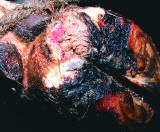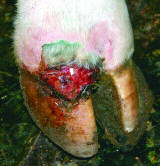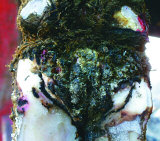Digital dermatitis


Authored by the
DIGITAL DERMATITIS (HEEL WART)
Digital dermatitis (DD) is a multi-
factorial superficial dermatitis of the
digital skin of cattle. The most
common site is the palmar/plantar
interdigital ridge of the foot—
especially the rear feet (Figure 1),
but other sites include the skin of the
interdigital cleft, the heel, sometimes
under-running the sole, and the
dorsal aspect of the coronary band
(Figure 2), where they may be
associated with a vertical wall crack.
Figure 1. Typical granulomatous
Necrotic lesions of the anterior udder
appearance to a DD lesion at the
have also been associated with the
plantar aspect of the interdigital
Figure 2. An atypical DD lesion
located on the dorsal aspect of the
coronary band.
Early lesions are erosive, circular or
oval with clearly demarcated raised
borders. Lesions may become red
Once introduced via the addition of
Constant moisture and low oxygen ten-
and granular or develop filiform
new cattle to the herd, DD spreads rap-idly, especially among the first and sec-
sion are required for infection to occur,
papillae (Figure 3) which are
ond lactation animals.
suggesting that wet, manure contami-
associated with the papillomatous
nated conditions are a pre-requisite for
form—known as the hairy heel wart.
Spirochetes from the genus Treponema
the organism(s) to penetrate the skin
have been identified consistently from
The lesions are very painful due to
lesions. However, DD has not been cre-
exposure of nerve endings, and
ated experimentally using any of the
Younger cattle appear to be moreaffected than older animals, and some
many have a characteristic odor
organisms identified alone, only byusing an exudate from active DD
cattle never develop lesions, suggesting
believed to be caused by break
lesions. The disease therefore appears
a degree of resistance. New cases are
down of keratin and secondary
to be multifactorial in nature, requiring
observed more commonly in early lacta-
infectious, immune and environmental
tion, suggesting that immune suppres-
sion around calving time may be a factorin the pathogenesis.
Important Things to Know About Digital Dermatitis
Other Predisposing Factors
Conformation may predispose individu-
DD is a multifactorial disease with infectious, immune and environmental
als to infection, with low heel heights
increasing the likelihood of disease.
Spirochetes from the genus Treponema are believed to be the infectious
The disease is more common in free stall
Lesions typically occur on the plantar aspect of the interdigital cleft and may
housing compared to tie stall and straw
be ulcerative, granulomatous or papillomatous in nature
bedded barns, and within free stall
Topical antibiotic treatment is effective
Foot hygiene and foot bath management are important aspects of control

Digital Dermatitis (Heel Wart) continued
can be soaked into a gauze swab and
fate (5–10%), formalin (2–5%), and
wrapped on the lesion.
commercial chemicals containing qua-ternary ammonium compounds, organic
A number of non-antibiotic commercial-
acids, and other disinfectants. Recently,
ly available alternatives exist that may
several new products which serve to
also be active topically for the treat-
activate copper sulfate have been
ment of individual cows.
released which allow lower concentra-
Parenteral antibiotics may be indicated
tions (2%) to be used.
for severe lesions, especially those onthe dorsal aspect of the claw, but they
It is essential that the volume of the
are secondary to topical treatments and
foot bath is known so that the correct
should not be used alone. In severe
amount of chemical may be used to pro-
cases, a NSAID may also be indicated.
vide the appropriate final concentration.
The volume in gallons may be calculated
Figure 3. A severe DD lesion with
from the formula; length × width ×
filiform papillae typical of the
depth (in inches) divided by 231.
papillomatous form of the disease
Animals should respond quickly to treat-ment. Wraps should be removed after
Foot baths should be at least 8 feet long
barns, use of automatic scrapers appears
3–4 days when the lesion can be checked
and 5 inches deep and as wide as the
to increase the risk by making cows step
for signs of healing (drying, darkening
alley way that they are located in. They
through large waves of manure as they
and absence of pain). Lesion recurrence
are commonly placed in the return lanes
progress through the pen.
rate 7–15 weeks after treatment may be
from the parlor or in a transfer lane.
high (60% has been reported).
Whatever the location, the alley must
DD appears to have been recognized
be wide enough to provide an alternate
with increasing frequency in beef cattle
route around the bath when it is not in
including feedyards and animals similar-
use. Wash baths sited in front of the
ly housed in dry lot conditions.
Hygiene is the most important control
treatment bath are optional, but if
measure for DD. Reducing exposure to
used, there should be a 6 foot gap in
Care should also be taken with regard
manure and avoiding chronic wetting of
between them, to prevent carry over of
to movement and use of trimming
the foot are paramount in reducing the
wash solution into the treatment bath,
equipment between farms, and ade-
risk of DD. Factors which improve leg
and dilution of the chemical. The floor
quate disinfection is essential.
hygiene include freestall pen design
of the bath should be non-slip, but not
(2-row pens have 20% more surface
too rough or ridged as this will prevent
area than 3-row pens), grooming of
cows from wanting to walk through it.
corrals to avoid wet areas, reducing
A range of topical antibiotics are effec-
stocking density, frequent manure
Foot bath frequency is determined by
tive, but all are extra-label uses in North
removal from alleyways by scraping or
leg hygiene and the extent of the DD
America requiring records of use. The
flushing at least three times per day,
problem in a herd. In highly contami-
lesion should be cleaned and dried and
and maintenance of watering and feed-
nated situations, bathing twice daily for
the antibiotic applied with a dressing or
ing areas to avoid mud accumulation.
at least 5 days per week is necessary,
topical spray.
Foot baths will help clean and disinfect
whereas in cleaner more hygienic condi-
the interdigital skin and are an integral
tions a bath run once per week may be
For topical spray treatments, oxytetracy-
part of DD control for most dairy herds.
cline (mixed at 10–25mg/ml) or lin-
Note that foot baths should not be used
comycin (mixed at 1–8mg/ml) are effec-
to treat active lesions—they are meant
Because of the susceptibility of early lac-
tive when mixed with distilled or deion-
to control the spread of infection by
tation animals, foot bathing should
ized water in a 2–4 liter agricultural
regular disinfection in much the same
begin in the close-up period and be
sprayer and applied once or twice daily
way that we use teat dipping to control
aggressively implemented in early lacta-
for 5–7 days. Alternatively, the prepared
the spread of mastitis pathogens. A
tion. AABP
solution of antibiotic (50–100 mg/ml
range of different products are effective
oxytetracycline or 8 mg/ml lincomycin)
including copper sulfate (5%), zinc sul-
Source: http://cdrf.org/wp-content/uploads/2012/06/AABP-Digital-Dermatitis.pdf
Slide 1 – Did you know? HK is drafting its first Biodiversity Strategy and Action Plan. We don't want to scare you about the environment, because we all know that we can do a lot better.So we want to share some good news about something amazing that is happening in HK, and how itapplies to you. HK is putting together its first Biodiversity Strategy and Action Plan (BSAP). This is HK's plan forurgent and effective action to stop biodiversity loss by 2020.
FUERZA AÉREA ARGENTINA DIRECCIÓN GENERAL DE SALUD RESPONSABLE DESIGNADO POR RESPONSABLE UNIDAD OPERATIVA RESPONSABLE UNIDAD EJECUTORA DE PLIEGO DE BASES Y CONDICIONES PARTICULARES Nombre del Organismo DIRECCIÓN DE BIENESTAR DEL PERSONAL (DI.B.P.F.A.) San José 317(1076) Capital Federal TEL.: 4383-0743 o 5173- 2331/Fax: 5173-2227E-MAIL: ([email protected])






